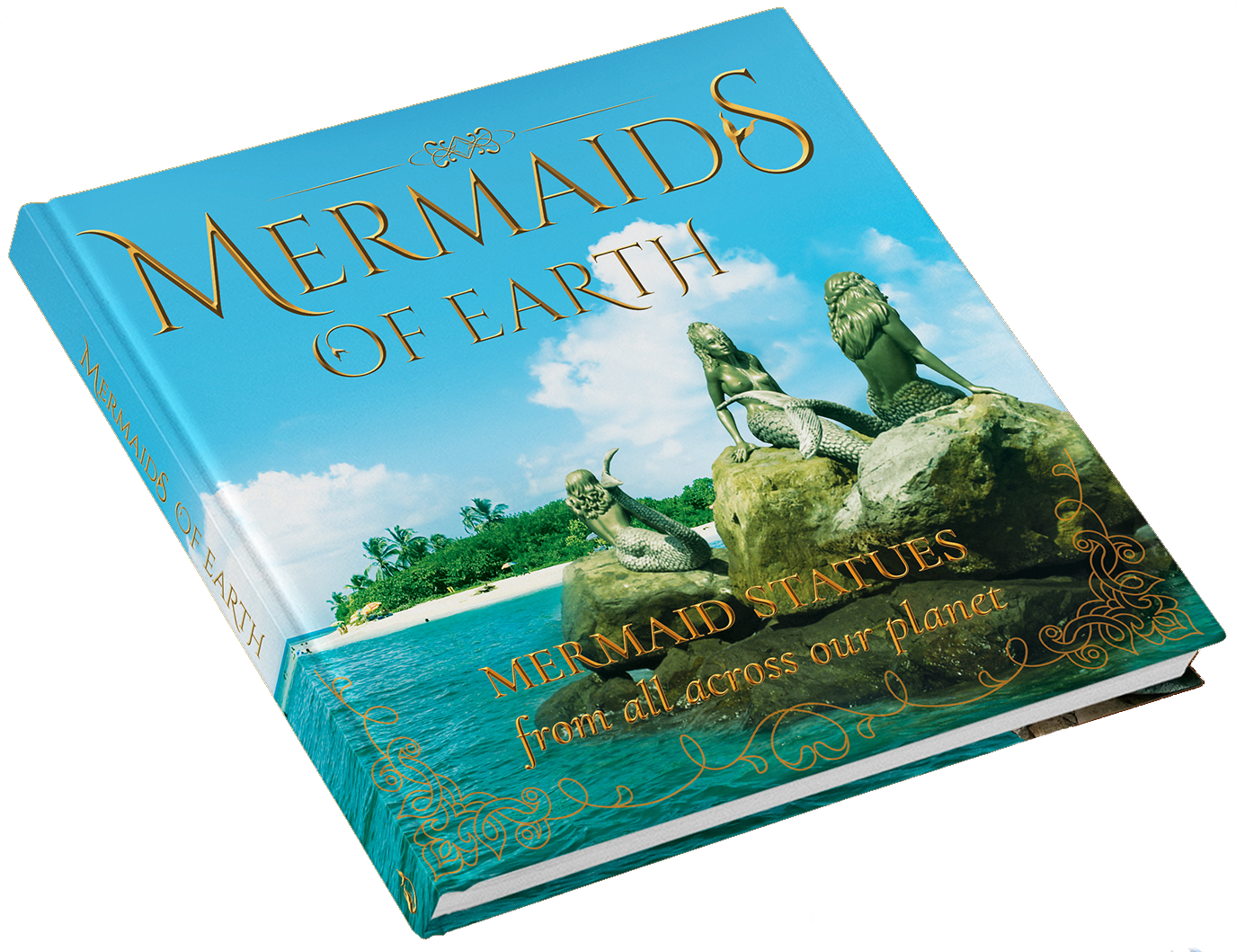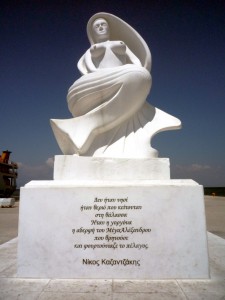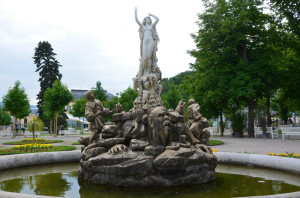On
The Origin of Mermaids
by means of Folklore, Legends & Mythology
I often am asked where the idea of mermaids came from, who came up with the idea, and whether they might exist or have existed at some point. After all, the concept of mermaids is so prevalent in human cultures all over the world. It is a fair question, and I devoted a chapter to this question in the Mermaids of Earth coffee-table book. (Click on the book image for more details)

The first known mention in human history of a human figure with a fish tail is from about 5000 BC, where Babylonian mythology of the god Ea described him as having the body of both a man and a fish. Ea was later known by the Greeks as Oannes, and by some Semitic tribes as Dagon.
But clearly Ea/Oannes was not a mermaid.

The first appearance of mermaids in human culture seems to have occurred about 1000 BC in Assyria (roughly equivalent to present-day Syria plus the northern area of Iraq). In the mythology of Assyria the beautiful fertility goddess Atargatis became a mermaid after casting herself into a lake.
The Assyrian mythology has several versions of events, but most include Atargatis falling in love with a mortal shepherd and having a daughter (the legendary Syrian Queen Semiramis) with him, after which she throws herself into a lake (from shame or from grief at inadvertently killing her lover, who didn't survive the divine lovemaking). Her beauty is such that she cannot die nor be fully transformed into a fish, and so she retains her feminine shape and beauty above the waist, while having a fish tail instead of legs. She is closely associated with the Syrian custom of not eating fish.
Atargatis becomes known to the Greeks as Aphrodite Derceto, with similar stories, and is incorporated into Greek mythology.
Greek mythology then greatly expands on the concept of mermaids, including in part the Nereids, the Tritons, the Sirens and Thessalonike (sister of Alexander the Great).
Here are the broad strokes of this Greek mythology as it pertains to mermaids:
Nereids, Triton and Mermaids

Cayman Islands
The Nereids were sea-nymphs and were portrayed at times with fish tails and at times with legs. There were 50 Nereids, all daughters of Nereus and Doris, inhabiting the Aegean Sea with their parents. A prominent Nereid was Thetis, mother of the great Homeric hero Achilles. Another prominent Nereid was Amphritite, who married Poseidon and bore Triton.

sculpture in Mexico
Nereus, father of the Nereids, was one of the Titans and was the oldest son of Pontus (the Sea) and Gaia (the Earth). He was considered the Old Man of the Sea, and was depicted as a human with a long fishlike tail. His wife Doris was the daughter of Oceanus and Tethys, both of whom were children of Uranus (the Sky) and Gaia. When the Titans were were overthrown by Zeus and his siblings, Nereus was replaced as ruler of the seas by Poseidon.
Amphitrite and Poseidon were the parents of Triton, who is a merman, and like the Nereids has the tail of a fish. Triton essentially inherited the kingdom of the sea from Poseidon, who inherited it from Nereus. Children today will recognize Triton as the father of Ariel, the Little Mermaid, in the Disney movie.
The Tritons are the descendants of Triton, and are mermen and mermaids.
The family tree is a bit unusual, but here is how it looks in a diagram:
(Gaia was mother of Pontus and Uranus. She had children with them both as well, and these children were
the Titans. Nereus and Doris (both Titans) had 50 Nereid daughters. One of these - Amphitrite - becomes
the wife of Poseidon (himself the son of two Titans), and they have Triton, a merman who becomes the
father and king of mermaids and mermen.)
Sirens
The mythology of Sirens is fairly confused, but Sirens in Greek mythology were originally women with the lower body and wings of a bird, who lured sailors to their death by singing with indescribably beautiful voices. Then at some point they lost their feathers in a singing contest with the Muses (goddesses of literature, science and the arts), and being now no longer able to fly they flung themselves into the ocean - where they either perished or transformed into mermaids, depending on which legend you read.
The Romans adopted the Sirens into Roman mythology as women with a fish tail, and that became the much preferred interpretation in later times. The Sirens were supposedly daughters of the river god Achelous, and this lends some weight to the fish-tail appearance. Later Roman mythology made the Sirens also extremely beautiful and seductive, but still equally deadly.
Later yet, the Greek and Roman mythologies on Sirens were mixed with local myths, legends and beliefs in other cultures.
In many languages today, the word "siren" is synonymous with mermaid. In Spanish, French, Italian, Polish, Romanian, Portuguese and Filipino the word for mermaid is respectively Sirena, Sirène, Sirena, Syrena, Sirenă, Sereia and Sirena.
Thessalonike
A completely separate legend is that of Thessalonike. She was the sister of Alexander the Great, and was immortalized when Alexander recovered a flask of water from the Fountain of Immortality and washed her hair with this immortal liquid.
When Alexander died, Thessalonike was grief-stricken and jumped into the sea to kill herself. Being immortal, she could not die and was transformed into a mermaid instead. In this form, Thessalonike roamed the Aegean Sea for centuries, often asking sailors on passing ships whether Alexander still lived. If they reassured her that he still lived and ruled she would let them pass. If they failed to reassure her, she turned into a monster and sent them to the bottom of the sea.
The legend is immortalized on the Greek island of Thasos with this mermaid statue. On the base is a poem by Greek poet Nikos Kazantzakis, which translates roughly as follows:
It was not an island
It was a beast lying
on the sea
It was the Mermaid
The sister of Alexander the Great
Who mourned
and made the sea rough
Later Mermaid Myths & Legends
Scottish mythology includes the Ceasg (maid of the wave), which has the form of a woman above the waist and the tail of a salmon below the waist. Ceasg can grant three wishes to those who capture them.
Both Ireland and Scotland have tales of the Merrow, which are human above the waist and have a fish tail below, and have webbed hands. They are benevolent and at time inter-marry with humans, taking human shape while on land. They wear a red cap while in the sea, which enables them to breathe underwater - and if you hide this cap from them they will stay with you on land.
The Isle of Man has the Ben-varrey, mermaids who can be both dangerous and helpful.
Scotland and the Faroe islands have legends and myths of Selkies, who live in the ocean in the shape of seals, but can shed their seal skin and live as humans. They can be trapped on land if their human lover or husband hides their seal skin, and there are a number of stories about the tragedies from such relationships. In one version, selkies are former humans who drowned themselves.
Mainland Europe has folklore about Melusine, a fresh-water mermaid (sometimes with wings as well, sometimes with a snake tail instead of a fish tail, and sometimes with two tails - as in the Starbucks logo). She married a human, but once a week she transformed into a mermaid while taking her bath. When her husband broke the agreement never to enter her bathing chamber while she was bathing, he saw her in her mermaid form and she left him forever. The Melusine story exists in several local legends - notably the City of Luxembourg has a legend that Count Siegfried of the Ardennes, who founded Luxembourg in the year 963, married Melusina. As in the other legends, she disappeared after he broke his promise and saw her taking a bath as a mermaid.
A separate legend has Melusine marrying Prince Raymondin of Poitou and with him forming the royal house of Lusignan. This is almost certainly the origin of illustrations showing a mermaid with a crown - and thus the original for the Starbucks mermaid.
German legends include Undine, a fresh-water sprite who is immortal yet has no soul. She can obtain a soul by marrying a human and bearing him a child. Legend tells that she marries a human, and bears him a child, after which she has a soul and starts to age. Her husband then is unfaithful and she curses him and returns to the water. The later famous story of Undine, written by Friedrich de la Motte Fouque in 1811 tells that Undine is born a mermaid, but is exchanged as a child for a human child by a river god. She marries a human and thereby obtains an immortal soul. Her husband later rejects her and Undine returns to the sea and her mermaid family, but warns her husband that he must remain faithful to her or she will be honor-bound to kill him. He fails to heed this sensible warning and recklessly marries a human woman – after which Undine kills him despite her love for him.
While the legends of Melusine inspired the Undine myth and story, so Undine seems to have inspired the fairy tale The Little Mermaid written by Hans Christian Andersen in 1836. This is the story of the little mermaid who falls in love with a human prince and gives up her voice and tail to become human and to get a human soul. In the Disney version she marries the prince and lives happily ever after, but in the original story the prince marries another and the little mermaid dissolves into sea foam - and is then rescued in the final moments.... You'll just have to read the original story, which inspired the world-famous Little Mermaid Statue in Copenhagen and which has inspired or been adapted into many other works of art.
The Russian Rusalkas share some of the traits of Sirens and Mermaids, although without a fish tail. They are the ghosts or undead remains of women or girls who die tragically or violently, and live on the bottom of rivers and lakes. They can be seductive and dangerous, pulling young men into the waters. They have perpetually wet hair as they would die if their hair dried, and often carry a comb which allows them to conjure water while on land. They often come out of the water at night and sing in trees or meadows.
China has tales of mermaids with webbed feet and hands, while Cambodia and Thailand have well known legends of the golden mermaid Suvannamaccha, a mermaid princess who falls in love with a human prince and has a child with him.
The African Mami Wata is a water sprite often shown as a mermaid. And in the Caribbean they have tales of Aycayia and La Sirene, both mermaids.
The Miengu (plural of Jengu) of Cameroon are normally said to be beautiful, mermaid-like figures with long, wooly hair and gap-toothed smiles. They live in rivers and the sea and bring good fortune to those who worship them.
In Brazil there is folklore about Iara, who is a mermaid, a water nymph or a siren depending on the context or story. Iara means something like Lady of the Lake or Water Queen. According to legend Iara is an immortal freshwater nymph in the appearance of a beautiful young woman with green hair and light skin who sits on a rock by the river combing her hair or dozing under the sun. When she feels a man around she sings to gently to lure him to her, to live out his life with her under the water.
Mermaids and mermen are also part of Philippine folklore, known as Sirena and Siyokoy respectively. They are human above the waist and have fish tails. They can be good or evil, sometimes drowning sailors after luring them into the water with their spellbinding songs, and at other times trying to rescue drowning sailors.
On Java there are many ancient legends, sagas, myths and folklore stories about the Javanese mermaid queen Nyi Roro Kidul. She is tied in with many of the royals in Javas history, and is considered the Queen of the South Sea (the Indian Ocean), and in control of the giant waves and Tsunamis that originate there. She is known to lure handsome young men into the sea from fishing boats or even the beach. She is aqua green in color, and it is part of local beliefs that aqua green is a sacred color, and that wearing this color will anger her.
On Geomundo Island in South Korea a local legend tells of the mermaid Sinjiki with fair white skin and long black hair. She appears mainly during bright moonlit evenings or in early mornings to warn fishermen about oncoming storms or typhoons by throwing rocks at a cliff or by making warning sounds.
Another local legend is found in Napier, New Zealand, where Pania of the Reef is the central character in a Maori legend of a sea-maiden who marries the son of the tribal chief and has a son with him, spending nights on land with her husband and child, and days in the sea with her mermaid people. She flees back into the ocean when he tries to make her permanently human.
There are countless other similar local legends across the world, with many of the same story elements.
Mermaid sightings
There is a theory that mermaid legends came about as a result of (presumably very drunk and very lonely) sailors mistaking manatees or dugongs (salt-water relatives of manatees) for attractive women with fish tails. While manatees can be very graceful in the water, they typically weigh in at over 1000 pounds and their faces are not easy to mistake for a woman's face. Nonetheless, three species of manatees and the one dugong species form the animal order of Sirenia, so named in honor of the 'drunk and lonely sailor' theory on the origin of Mermaids.
Maybe 'drunk and lonely sailor' is too harsh. Christopher Columbus reported seeing three mermaids, although 'not as beautiful as they are represented.' And the famous English pirate Blackbeard (Edward Teach) reported seeing mermaids.
Aquatic Ape Theory
Another theory of mermaid (and human) origin is that fairly advanced primates - living by wading in sea water and eating marine animals - adapted to living in water by becoming largely hairless and bipedal. It has been suggested that some of these aquatic apes evolved into modern humans, while others evolved into mermaids. The Aquatic Ape Theory of human evolution is not widely accepted in the scientific community, and there does not appear to be any scientific evidence whatsoever for the Aquatic Ape Theory of mermaid evolution (or for the existence of mermaids at all)
Conclusion
Mermaids have been part of human culture for thousands of years, with the most major influence from Greek and Roman mythology. But has also been much influence from many other cultures across the globe, both before and after the Greeks and Romans.
Mermaids have been seens as forces for both good and evil from the start, and this tradition continues to this day, although the general tendency in current culture is to regard them as mostly benign, beautiful, attractive, independent and as interested in humans. And they have evolved into symbols of ocean conservation, marine species conservation and the responsible and sustainable care of ocean ecology.
So what is the origin of mermaids? Perhaps my granddaughter Siena has the plainest answer:
"Mermaids are just there, like elephants, and whales and dinosaurs".




